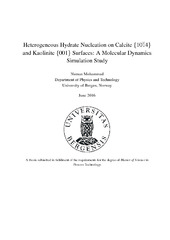| dc.description.abstract | Natural gas hydrates are of significant interest due to the great amount of methane that can potentially be utilised as an energy source. These methane resources are trapped in ice-like form, which is a concern since hydrates will dissociate upon contact with water. This type of contact happens worldwide through fracture systems that bring seawater or groundwater into the hydrate layers. The result is the release of methane into the ocean, which adds to the carbon content of the ocean. In some cases, the methane bubbles directly through the water column and into the air. The global temperature increase also leads to decreased thickness of the stability region for these hydrates. These methane leaks are a climate concern, as methane is substantially more aggressive than carbon dioxide as a greenhouse gas. This constant hydrate dissociation can also eventually lead to geomechanical instability and associated catastrophic events. Many of the natural gas hydrate systems are in a dynamic mode of hydrate dissociation and hydrate formation from gas supplied through fracture systems below the hydrate layers. Over geological time scales these systems have entered an almost stationary situation of hydrate dissociation from the top and the new hydrate formation from bottom of the hydrate layers. Calcite, a natural polymorph of calcium carbonate, and kaolinite, a clay mineral, are important minerals in oil and gas reservoirs and gas hydrate-bearing sediments. Therefore, these minerals can influence the hydrate morphology along with the other necessary (formation) conditions. The main objective of this thesis was to use molecular dynamics simulation to investigate heterogeneous hydrate nucleation in systems that allowed mineral (calcite {1014} and kaolinite {001} surfaces ), water and methane interactions at a constant temperature (273 K) and pressure (100 bar). The calculated structures and adsorption profiles of water from the calcite system samplings are in good agreement with experimental and theoretical studies. The peaks of the primary adsorbed layer of water in the density profiles were found at a distance 2.28 Å, 2.73 Å, and 2.76 Å from the calcite, octahedral, and tetrahedral surfaces, respectively, which are in good agreement with theoretical studies. The hydrogen bonding network between water molecules in the first adsorbed layer was completely distorted as a result of strong calcite-water interactions. Furthermore, kaolinite surfaces disturbed this network to some extent. The surface hydroxyl group, acting as both a proton donor and acceptor, was the dominant feature of the octahedral surface to adsorb water. Hydrogen bonding and density profile analysis at the solid-water interface emphasised the hydrophobic nature of the tetrahedral surface. It was found that methane adsorbed better on the kaolinite surfaces compared to the calcite surface in an aqueous environment. Kaolinite surfaces could provide better hydrate nucleation sites due to good adsorption capability for methane and efficient adsorption sites for water without any significant distortion of the hydrogen bonding network between water molecules. | en_US |
